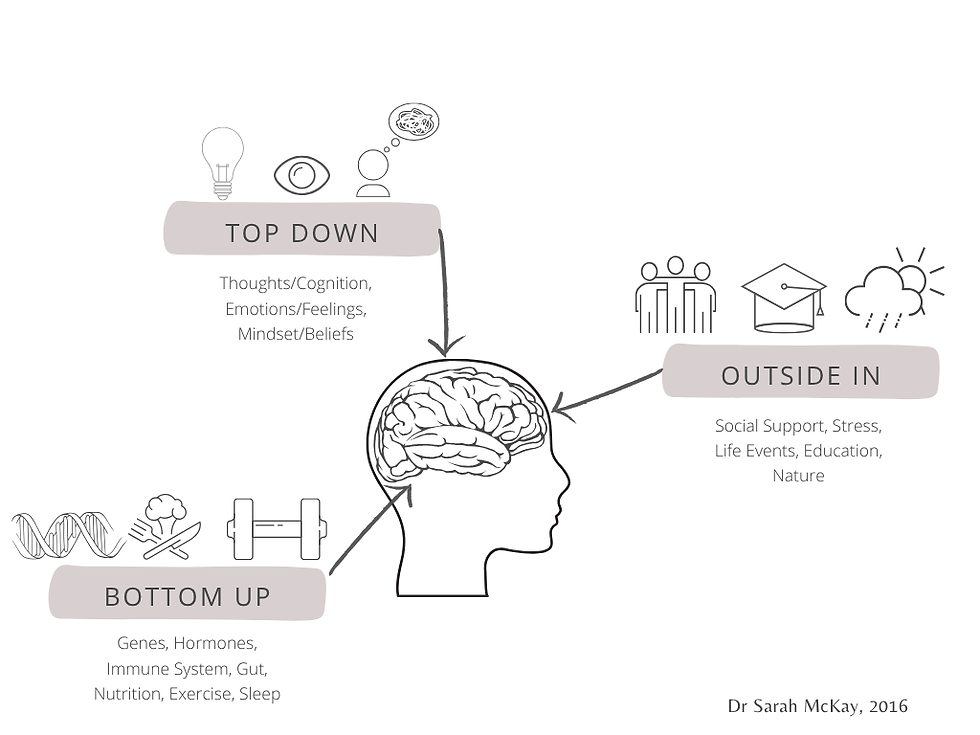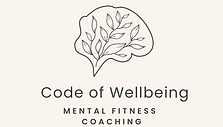The Bottom-Up, Top-Down, and Outside-In Model: A Powerful Approach to Nervous System Regulation
- Ute Lorch
- Jul 23
- 3 min read
Updated: Dec 8
In the fast-evolving field of neuroscience and mental wellbeing, Dr. Sarah McKay—a respected neuroscientist and science communicator—offers a refreshingly practical and holistic framework for understanding how we can influence our own nervous system health and emotional regulation. She calls it the Bottom-Up, Top-Down, and Outside-In model.

This model bridges the gap between science and lived experience, giving us insight into how brain-body regulation happens not just from our thoughts, but also from our actions, environments, and sensations.
Let’s break it down—and explore how applying it can support vagus nerve tone, emotional resilience, and long-term wellbeing.
1. Bottom-Up: Body to Brain
Bottom-up regulation refers to how sensory input and physical states from the body affect the brain. This includes signals from muscles, organs, breathing patterns, posture, and movement. One of the key pathways here is the vagus nerve—the superhighway connecting the body to the brainstem and influencing everything from digestion to heart rate to emotional calm. Low vagal tone, reflected in reduced heart rate variability, has been linked to slower stress recovery and emotional dysregulation (Thayer & Lane, 2000; Porges, 2011).
Practices that support bottom-up regulation include:
Bottom-up practices include:
Deep breathing (especially slow, diaphragmatic breathing)
Cold exposure (splashing the face or cold showers)
Gentle movement (like yoga, walking, or somatic shaking)
Interoception (tuning into bodily sensations without judgment)
These activities can stimulate the vagus nerve, increasing vagal tone, which is linked with improved mood, better heart rate variability (HRV), and greater emotional flexibility.
2. Top-Down: Brain to Body
Top-down regulation refers to how our thoughts, beliefs, focus, and interpretations influence the body’s physiological state.
Cognitive practices can change neural pathways, particularly those involving the prefrontal cortex and amygdala, reducing sympathetic activation (fight/flight) and promoting calm. Evidence shows mindfulness, cognitive reframing, and gratitude practices reduce amygdala activation and strengthen self-regulation networks (Hölzel et al., 2011; Davidson & McEwen, 2012).
Top-down practices include:
Mindfulness meditation,
Cognitive reframing,
Self-compassion and gratitude,
Visualisation and mental rehearsal
3. Outside-In: Environment to Brain and Body
The outside-in component focuses on the impact of our environment and relationships on our nervous system. Humans are deeply social beings, wired for connection, safety, and co-regulation. Our nervous system doesn't operate in isolation—it continuously responds to light, sound, nature, touch, and social cues.Environmental enrichment and co-regulation through trusted relationships improve vagal tone and reduce inflammation (Panksepp, 1998; Cozolino, 2014).
Outside-in strategies include:
Spending time in nature,
Healthy, safe relationships,
Touch and physical closeness,
Music, rhythm, and safe soundscapes,
Light exposure (especially natural morning light).
Why This Model Matters for Vagus Nerve Health
The vagus nerve is the main communication channel between the body and brain in the parasympathetic (rest-and-digest) system. When vagal tone is high, the body and brain are better equipped to:
Regulate emotions,
Recover from stress,
Sleep deeply,
Digest properly,
Connect socially.
By working through all three lenses—bottom-up, top-down, and outside-in—we can actively stimulate the vagus nerve and teach our nervous system to feel safe, flexible, and resilient.
Practical Application
To support your nervous system daily:
Morning (Bottom-Up): Begin with 3 minutes of slow breathing or stretching.
Midday (Top-Down): Pause to reframe a stressful thought or express gratitude.
Evening (Outside-In): Connect with nature, calming sounds, or trusted people.
The Takeaway
Dr. Sarah McKay’s model offers a powerful, integrated way to support brain and body health—not just by thinking differently, but by living differently.
Understanding that we can regulate from multiple directions—bottom-up, top-down, and outside-in—empowers us to take consistent, compassionate steps toward greater wellbeing. References
Thayer, J.F., & Lane, R.D. (2000). A model of neurovisceral integration in emotion regulation and dysregulation. Journal of Affective Disorders, 61(3), 201–216.
Porges, S.W. (2011). The Polyvagal Theory: Neurophysiological foundations of emotions, attachment, communication, and self-regulation. Norton.
Hölzel, B.K. et al. (2011). Mindfulness practice leads to increases in regional brain gray matter density. Psychiatry Research: Neuroimaging, 191(1), 36–43.
Davidson, R.J., & McEwen, B.S. (2012). Social influences on neuroplasticity: Stress and interventions to promote well-being. Nature Neuroscience, 15(5), 689–695.
Panksepp, J. (1998). Affective Neuroscience: The foundations of human and animal emotions. Oxford University Press.
Cozolino, L. (2014). The Neuroscience of Human Relationships: Attachment and the developing social brain. Norton.




Comments